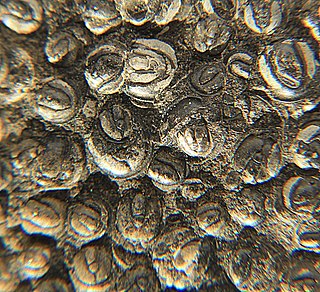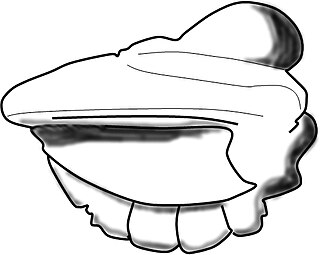The Cambrian Period was the first geological period of the Paleozoic Era, and of the Phanerozoic Eon. The Cambrian lasted 55.6 million years from the end of the preceding Ediacaran Period 541 million years ago (mya) to the beginning of the Ordovician Period 485.4 mya. Its subdivisions, and its base, are somewhat in flux. The period was established by Adam Sedgwick, who named it after Cambria, the Latin name of Wales, where Britain's Cambrian rocks are best exposed. The Cambrian is unique in its unusually high proportion of lagerstätte sedimentary deposits, sites of exceptional preservation where "soft" parts of organisms are preserved as well as their more resistant shells. As a result, our understanding of the Cambrian biology surpasses that of some later periods.

Trilobites are a group of extinct marine artiopodan arthropods that form the class Trilobita. Trilobites form one of the earliest-known groups of arthropods. The first appearance of trilobites in the fossil record defines the base of the Atdabanian stage of the Early Cambrian period, and they flourished throughout the lower Paleozoic before slipping into a long decline, when, during the Devonian, all trilobite orders except the Proetida died out. The last extant trilobites finally disappeared in the mass extinction at the end of the Permian about 252 million years ago. Trilobites were among the most successful of all early animals, existing in oceans for almost 300 million years.

Agnostus, is a genus of agnostid trilobite belonging to the Family Agnostidae, that lived during the late Middle Cambrian – early Upper Cambrian. It is the type genus of the family Agnostidae and is subdivided into two subgenera, Agnostus and Homagnostus.
The Kaili Formation is a stratigraphic formation which was deposited during the Lower and Middle Cambrian. The formation is approximately 200 metres (660 ft) thick and was named after the city Kaili in the Guizhou province of southwest China.
Eoagnostus is an extinct genus from a well-known class of fossil marine arthropods, the trilobites. It lived during the terminal Lower Cambrian (Toyonian), until the earliest Middle Cambrian.

Chelediscus Rushton, 1966, is a genus of Eodiscinid trilobite belonging to the family Weymouthiidae Kobayashi T. (1943), Order Agnostida Salter (1864). The Treatise assigns this genus to the Calodiscidae; Cotton and Fortey (2005) however move it to the Weymouthiidae. Chelediscus lived during the later part of the Botomian stage.
Lemdadella is an extinct genus of redlichiid trilobites that lived during the late Atdabanian stage, which lasted from 530 to 524 million years ago during the early part of the Cambrian Period.

Peronopsis is a genus of trilobite restricted to the Middle Cambrian. Its remains have been found in Asia, Australia, Europe, and North America.
Trilobites are used as index fossils to subdivide the Cambrian period. Assemblages of trilobites define trilobite zones. The Olenellus-zone has traditionally marked the top of the Lower Cambrian, and is followed by the Eokochaspis zone.
Oryctocephalus indicus is a species of corynexochid trilobite from the Cambrian. Its first appearance is proposed for the lower boundary of the Wuliuan, which corresponds to the beginning of the Miaolingian. The species was first described by the British paleontologist Frederick Richard Cowper Reed in 1910 as Zacanthoides indicus. It was transferred to the genus Oryctocephalus by the American paleontologist Charles Elmer Resser in 1938.
The Wuliuan stage is the fifth stage of the Cambrian, and the first stage of the Miaolingian Series of the Cambrian. It was formally defined by the ICS in 2018. Its base is defined by the first appearance of the trilobite species Oryctocephalus indicus; it ends with the beginning of the Drumian stage, marked by the first appearance of the trilobite Ptychagnostus atavus around 504.5 million years ago.
Stage 10 of the Cambrian is the still unnamed third and final stage of the Furongian series. It follows the Jiangshanian and precedes the Ordovician Tremadocian stage. The proposed lower boundary is the first appearance of the trilobite Lotagnostus americanus around 489.5 million years ago, but other fossils are also being discussed. The upper boundary is defined as the appearance of the conodont Iapetognathus fluctivagus which marks the beginning of the Tremadocian and is radiometrically dated as 485.4 million years ago.
The Miaolingian is the third Series of the Cambrian period, and was formally named in 2018. It lasted from about 509 to 497 million years ago and is divided in ascending order into 3 stages: the Wuliuan, Drumian, and Guzhangian. The Miaolingian is preceded by the unnamed Cambrian Series 2 and succeeded by the Furongian series.
Cambrian Stage 3 is the still unnamed third stage of the Cambrian. It succeeds Cambrian Stage 2 and precedes Cambrian Stage 4, although neither its base nor top have been formally defined. The plan is for its lower boundary to correspond approximately to the first appearance of trilobites, about 521 million years ago, though the globally asynchronous appearance of trilobites warrants the use of a separate, globally synchronous marker to define the base. The upper boundary and beginning of Cambrian Stage 4 is informally defined as the first appearance of the trilobite genera Olenellus or Redlichia around 514 million years ago.
Cambrian Stage 4 is the still unnamed fourth stage of the Cambrian and the upper stage of Cambrian Series 2. It follows Cambrian Stage 3 and lies below the Wuliuan. The lower boundary has not been formally defined by the International Commission on Stratigraphy. One proposal is the first appearance of two trilobite genera, Olenellus or Redlichia. Another proposal is the first appearance of the trilobite species Arthricocephalus chauveaui. Both proposals will set the lower boundary close to 514 million years ago. The upper boundary corresponds to the beginning of the Wuliuan.
Cambrian Series 2 is the unnamed 2nd series of the Cambrian. It lies above the Terreneuvian series and below the Miaolingian. Series 2 has not been formally defined by the International Commission on Stratigraphy, lacking a precise lower boundary and subdivision into stages. The proposed lower boundary is the first appearance of trilobites which is estimated to be around 521 million years ago.
Diplorrhina Hawle and Corda (1847) is a genus of trilobite belonging to Order Agnostida. It lived during the early Middle Cambrian in what are now the Czech Republic and the North Siberian plateau. as in members of the family Peronopsidae it lacks a preglabellar furrow. Both cephalon and pygidium lack spines. It is difficult to distinguish Diplorrhina from many other peronopsids.
Ovatoryctocara is a genus of small corynexochid trilobites from the Cambrian, that lived in what now are Siberia, China, Greenland and Canada (Newfoundland). Ovatoryctocara can be recognised by the combination of the following characters: the central raised area of the cephalon is approximately cylindrical and has two rows of four triangular or round pits. The thorax only has 5 or 6 segments. The tailshield has an axis of 6 to 12 rings, the pleural furrows are well developed and the border is absent or narrow as a hair.
This list of fossil arthropods described in 2015 is a list of new taxa of trilobites, fossil insects, crustaceans, arachnids and other fossil arthropods of every kind that have been described during the year 2015. The list only includes taxa at the level of genus or species.

Plutonides Hicks, 1895, is a genus of Middle Cambrian trilobite belonging to the Paradoxididae. In terms of the Scandinavian Middle Cambrian sequence the genus ranges from the Baltoparadoxides oelandicus Biosuperzone on Trwyncynddeiriog headland located 1.3 km SSW of St David’s Cathedral and 500 m east of Porth Clais Harbour - Pen-y-Cyfrwy Member, Newgale Formation, and possibly to middle part of the Mawddachites hicksii Biozone on the Penpleidiau (eastern) Headland of Caerfai Bay south of St David’s in SW Wales, Locs. TC-1 & CF-1 of Rees et al.,.




